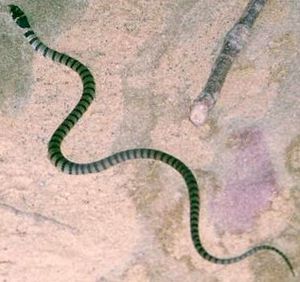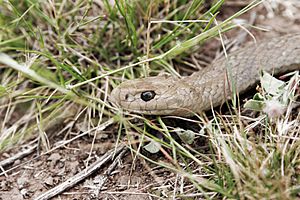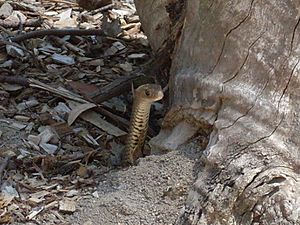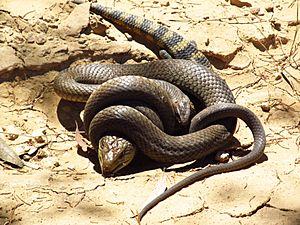Eastern brown snake facts for kids
Quick facts for kids Eastern brown snake |
|
|---|---|
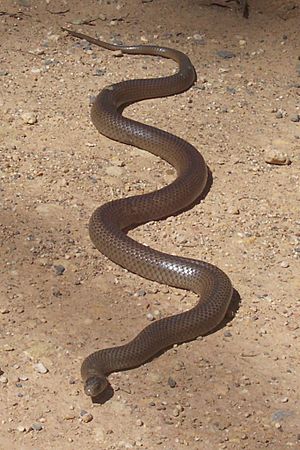 |
|
| Eastern brown snake, NSW, Australia | |
| Conservation status | |
| Scientific classification | |
| Genus: |
Pseudonaja
|
| Species: |
textilis
|
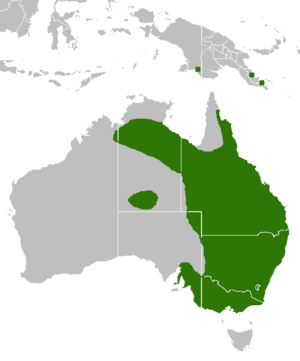 |
|
| Range of eastern brown snake (in green) | |
| Synonyms | |
|
List
Furina textilis
A.M.C. Duméril, Bibron & A.H.A. Duméril, 1854 Pseudonaja textilis – McDowell, 1967 |
|
The eastern brown snake (Pseudonaja textilis), also called the common brown snake, is a very venomous snake. It lives in eastern and central Australia and southern New Guinea. A French zoologist named André Marie Constant Duméril first described it in 1854.
Adult eastern brown snakes can grow up to 2 meters (7 feet) long. They have a slender body. Their color can be light brown to almost black, but their belly is usually pale cream or yellow. Sometimes, they have orange or grey spots underneath. These snakes live in many places, but not in thick forests. They are often found on farms and near cities. This is because their favorite food, the house mouse, is common in these areas. The eastern brown snake lays eggs. Experts consider it a "least concern" species, meaning it's not currently endangered.
This snake is known as the world's second-most venomous land snake. It causes about 60% of snake-bite deaths in Australia. Its venom mainly affects the blood, causing bleeding and problems with circulation.
Contents
About the Eastern Brown Snake
Naming and Discovery
In 1790, John White wrote about many Australian animals for the first time. He described a snake that sounds like the eastern brown snake, but he didn't name it. Later, in 1854, French zoologist André Marie Constant Duméril officially described the species. He named it Furina textilis. The name came from the fine, knitted-like pattern he saw on the snake.
Over time, scientists realized that different snakes they had named were actually all the same species. In 1862, Gerard Krefft noticed that young brown snakes had different markings than adults. He helped show that many of the earlier names were for the same snake at different ages. Eventually, the snake was placed in the group Pseudonaja, which is where it stays today.
The Eora and Darug people of the Sydney area called this snake marragawan. The Dharawal people of the Illawarra called it goobalaang.
What Does it Look Like?
The eastern brown snake has a slim body, and its head isn't much wider than its neck. Most are about 1.5 meters (5 feet) long, but some can reach 2 meters (7 feet). The biggest ever found was 2.4 meters (8 feet). Snakes from northern Australia tend to be larger.
Their color varies a lot. They can be light brown, dark brown, orange, or reddish on top. Snakes from New Guinea might be tan, olive, or even very dark grey-brown.
Their fangs are quite small compared to other dangerous Australian snakes, usually less than 3 mm long. Their tongue is dark, and their eyes have blackish centers with a lighter yellow-brown or orange ring. The chin and belly are cream or pale yellow. Sometimes, they have orange, brown, or dark grey spots on their belly.
Young eastern brown snakes look different. They often have a black head with a lighter snout and a black band behind their head. Their bodies can be plain brown, have many black bands, or a net-like pattern. These darker markings usually fade as the snake gets older.
It can be tricky to tell eastern brown snakes apart from other snakes. Their yellowish belly helps tell them apart from the dugite and peninsula brown snake. The inside of their mouth is pink, unlike the black mouths of some other brown snakes. Large eastern brown snakes might be confused with mulga snakes, but brown snakes have smaller heads. Young eastern brown snakes can look similar to red-naped snakes or grey snakes.
Where They Live
The eastern brown snake lives along the east coast of Australia. You can find them from far north Queensland, through Queensland, New South Wales, and Victoria, down to South Australia. They also live in parts of the Northern Territory and a small area of Western Australia. You can also find them in parts of New Guinea.
These snakes live in many different places. They like dry forests, woodlands, grasslands, and even dry farmlands. They are common in open areas and on the edges of towns. You won't find them in rainforests or very wet places. Because they eat rodents, they are often found near houses and farms. They like to hide under things like old metal sheets, in burrows, or in cracks in the ground.
How They Behave
Eastern brown snakes usually live alone. They are active during the day. On very hot days, they might rest during the hottest part and come out in the late afternoon. They are most active in spring, but you might see them on warm winter days too.
These snakes are very fast movers. When they feel threatened, they don't always attack. Often, they will try to get away or hide. If they feel they need to defend themselves, they might raise the front part of their body off the ground. They can flatten their neck into an S-shape and open their mouth. From this position, they can strike accurately. Because they can rise quite high, bites often happen on a person's upper leg.
Life Cycle and Food
Reproduction
Eastern brown snakes usually mate in early October, during the spring in the Southern Hemisphere. Males might wrestle with other males to win the right to mate with females.
Females lay a clutch of 10 to 35 eggs. Each egg weighs about 8 grams. They lay their eggs in safe, hidden places, like burrows or inside hollow logs. Sometimes, several females might even use the same spot, like a rabbit warren. How fast the eggs hatch depends on the temperature. In warmer conditions, they hatch much faster. Eastern brown snakes can start having babies when they are about 31 months old. They can live up to 15 years in captivity.
What They Eat
The eastern brown snake seems to hunt mostly by sight. When it's looking for food, it often raises its head like a periscope to look around. It usually finds its food hiding rather than chasing it. Adults hunt during the day, but young snakes might hunt at night. They rarely eat in winter, and females usually don't eat when they are pregnant.
Eastern brown snakes often coil around and squeeze their prey to stop it from moving. Their diet is mostly made up of other animals, especially mammals. The introduced house mouse is a favorite food. They can even eat mammals as big as rabbits. They also eat small birds, eggs, and sometimes other snakes. Snakes that live in natural areas or pastures eat more reptiles, while those in crop fields eat more mice. As they grow bigger, they tend to eat more warm-blooded animals.
Snake Venom and Treatment
Venom Effects
The eastern brown snake is considered the second-most venomous land snake in the world. It causes more snakebite deaths in Australia than any other snake. It's a common dangerous snake in cities like Adelaide, Melbourne, Sydney, and Brisbane.
If bitten, the venom can cause serious problems with blood clotting and bleeding. People might feel sick, vomit, sweat a lot, or have stomach pain. In severe cases, it can lead to collapse or heart problems. Symptoms can appear very quickly, sometimes within minutes. There is often little pain or swelling where the bite happened. You might see two small fang marks about 1 cm apart.
The eastern brown snake doesn't inject a lot of venom, usually less than 5 mg. But even a small amount is very powerful. The venom contains special proteins that affect the blood, making it unable to clot properly. This leads to bleeding. It also has toxins that can affect nerves, but these effects are usually mild in humans.
Dogs and cats can also be bitten by eastern brown snakes. They are more likely to show nerve-related symptoms like weakness or paralysis.
What to Do if Bitten
If someone is bitten by a suspected venomous snake, it's very important to act quickly.
- Apply a pressure bandage to the bite site.
- The person should move as little as possible.
- Get them to a hospital or clinic right away. They will need to be watched for at least 24 hours.
The main treatment is to give the right antivenom. Brown snake antivenom has been available since 1956. It helps to stop the venom from causing more harm. Dogs and cats can also be treated with a special antivenom made for them.
Keeping Them as Pets
Eastern brown snakes can be bought in Australia from breeders. However, they are considered very challenging to keep as pets. Because they are so fast and their venom is so dangerous, they are only suitable for very experienced snake keepers.
Images for kids
See also
 In Spanish: Serpiente marrón oriental para niños
In Spanish: Serpiente marrón oriental para niños



